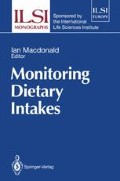Abstract
Data on the intake of foods and food constituents (nutrients, contaminants, additives, etc.) are needed to:
-
Estimate health risks from food constituents as a basis for recommendations on dietary habits
-
Carry out epidemiological studies on the relation between dietary components and health
-
Study time-trends in dietary intakes and thus obtain an early warning of impending problems
-
Set maximum permitted levels for additives and contaminants in foods
Access this chapter
Tax calculation will be finalised at checkout
Purchases are for personal use only
Preview
Unable to display preview. Download preview PDF.
References
WHO (1989) Guidelines for predicting dietary intake of pesticide residues. Report pre-pared by the Joint UNEP/FAO/WHO Food Contamination Monitoring Programme in collaboration with the Codex Committee on Pesticide Residues, World Health Organization, Geneva
Vahter M, Slorach SA (1990) Exposure monitoring of lead and cadmium. An international pilot study within the WHO/UNEP Human Exposure Assessment Location ( HEAL) Programme United Nations Environment Programme. Nairobi
Nordisk dioxinriskbedomning (Nordic evaluation of health risks from dioxin) (1988) Report from a Nordic expert group. Nordic Council of Ministers report NORD 1988: 49, Copenhagen
Noren K (1988) Changes in the levels of organochlorine pesticides, polychlorinated biphenyls, dibenzo-p-dioxins and dibenzofurans in human milk from Stockholm 1972–1985. Chemosphere 17: 39–49
Author information
Authors and Affiliations
Editor information
Editors and Affiliations
Rights and permissions
Copyright information
© 1991 Springer-Verlag Berlin Heidelberg
About this chapter
Cite this chapter
Slorach, S.A. (1991). Future Trends and Co-operation Concerning Intake Studies. In: Macdonald, I. (eds) Monitoring Dietary Intakes. ILSI Monographs. Springer, London. https://doi.org/10.1007/978-1-4471-1828-2_23
Download citation
DOI: https://doi.org/10.1007/978-1-4471-1828-2_23
Publisher Name: Springer, London
Print ISBN: 978-1-4471-1830-5
Online ISBN: 978-1-4471-1828-2
eBook Packages: Springer Book Archive

